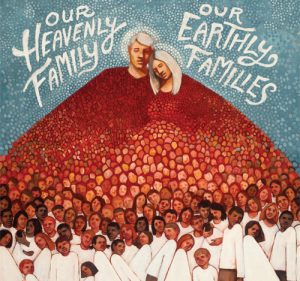 McArthur Krishna, along with Bethany Brady Spalding and Caitlin Connolly, were the recipients of the 2016 AML Picture Book Award for Our Heavenly Family, Our Earthly Families (Deseret Book). McArthur is interviewed here by Rachel Davis, who often reviews LDS children’s books and teaching materials.
McArthur Krishna, along with Bethany Brady Spalding and Caitlin Connolly, were the recipients of the 2016 AML Picture Book Award for Our Heavenly Family, Our Earthly Families (Deseret Book). McArthur is interviewed here by Rachel Davis, who often reviews LDS children’s books and teaching materials.I know you and Bethany worked together before on a pair of Girls who Choose God books. How did your collaboration with Caitlin Connolly come about?
Bethany and I knew we needed a different artist since this book was not part of the Girls Who Choose God series so we started looking around. I tried to get in touch with Caitlin… and so I called and emailed and called and emailed… and got nothing back. Finally I called a mutual friend and said, “Can you please call Caitlin and tell her I’m not crazy?” There was a long pause on the phone and then he said, “But you are crazy.” Fine point. But he must have put in a good word because I was finally able to catch up with her. She had valid concerns about the fact she doesn’t do illustration work or commissions… but I assured her we wanted fine art and were not going to art direct. I almost stuck to that promise! And, as Bethany says, my real superpower is actually not writing but relentless creative problem solving. (Which is a nice way of saying I can be a pain.) When we explained what the concept was about we could tell that Caitlin got excited about trying to show the power and grace and quirkiness of family life— and since families are THE eternal model, it may be the most important work we do to help boost family life. The book presented opportunities that no one stepped into before.

Which came first, the art or the text? I am fascinated that a book with such a strong voice both visually and verbally could come from three individuals. Please share how the collaborative process worked between the three of you.
Bethany and I did the text first and then handed it off to Caitlin. Working with Bethany is easy– we can’t even remember who did what part because we are so unified in what we are trying to accomplish. I do a little here, she does a little there, the other one has an idea and makes it better, and we tweak it again, repeat. Bethany is superb at keeping to the point— she ensures that we always are dead on with what we are trying to say and how we say it. So, I guess it is three individuals but two of us are completely synched. When we handed the text off to Caitlin we all had a conversation about how we wanted this book to communicate… but clearly we knew we were getting the signature Caitlin style. Lucky us!
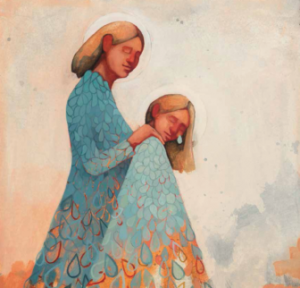 The Girls Who Choose God books had a clear purpose and filled a need in our community. Did you feel a similar sense of mission or purpose when you set about to create Our Heavenly Family? Can you share more about what you hope to achieve with the book?
The Girls Who Choose God books had a clear purpose and filled a need in our community. Did you feel a similar sense of mission or purpose when you set about to create Our Heavenly Family? Can you share more about what you hope to achieve with the book?The genesis of the Family book was actually the clear hole we have in our faith community about lack of material on Heavenly Mother. As lds.org states it is one of our “cherished” doctrines- but we as a community almost NEVER speak of Her. This, frankly, baffles me. How can we talk about our divine purpose and not acknowledge this exciting truth? This was a clear mission.But, we ultimately realized that as much as we needed to create ways to include Her in our faith, that She alone was not the point. This life development IS about family– whatever form that means for each of us. With that realization it was clear we should do a family book with our Heavenly Mother in Her proper place as loving mother to all of us. What did we hope to accomplish? We hoped to let Heavenly Mother be part of the family… and strengthen each of our families… and open the door that families aren’t perfect… nor cookie cutter. We hoped to offer hope and patience for family in process… as it is for all of us. We hoped to acknowledge all families are a little crazy… and that’s just fine.Family life is both the most glorious and the hardest thing I know. This is true for my family or origin and the family I started creating when I married at age 37. Family can be overwhelming… (and I got a fabulous family!) But, the doctrine of eternal family infuses energy into a situation that may otherwise seem as though it demands too much of us. Truly, building a family demands ALL. But ALL is what we get back as well.
Bethany and I consider lots of things… but mostly how to make something WORK. Girls Who Choose God told narratives… this highlights themes. For different subjects, different approaches work better. So, actually, the subject informs the structure in this case. Future projects would have a totally different shape, perhaps.
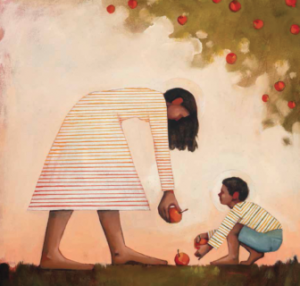 Our Heavenly Family folds in many key principles from The Family Proclamation and even quotes The Proclamation itself. My experience is that The Family Proclamation has fueled some controversy among members of our faith. Part of what I really love about this book is the way you dance around The Family Proclamation so deftly. Could you talk more about your personal relationship to The Family Proclamation and the influence of The Family Proclamation on the book?
Our Heavenly Family folds in many key principles from The Family Proclamation and even quotes The Proclamation itself. My experience is that The Family Proclamation has fueled some controversy among members of our faith. Part of what I really love about this book is the way you dance around The Family Proclamation so deftly. Could you talk more about your personal relationship to The Family Proclamation and the influence of The Family Proclamation on the book?McArthur: The Proclamation is now twenty years old. Amazing. I remember when it first came out how deeply thrilled I was… thrilled may not be the right word… deeply peaceful is better… about finally seeing the term “co-equal” used for wives and husbands. That concept was something I had always believed but not always heard articulated in a church setting. In fact, I had often been told by well-meaning people that I just didn’t get it. To finally have something solid and real and OFFICIAL just made me exhale– and think I could believe in that kind of marriage.The Proclamation on the Family opened the door for us to do a book using our Heavenly Parents as it clearly stated some of what we know of Them. We do, of course, wish that the term Heavenly Mother was not only used in the Proclamation but in all accurate places. For example, recently I sat in a Sunday School lesson all about nurturing children and all the language was about Heavenly Father. I appreciate that— I have felt deeply nurtured by my Father in Heaven. However, it takes nothing away from Him to include the divine nurturing role of our Heavenly Mother. If we as women are told in the Proclamation that we are responsible for nurturing our children, I would assume this is based on a correct eternal model of a Heavenly Mother who also nurtures. Wouldn’t it be lovely to inspire us and our youth today with the truth and power of that role?Ps: I love deft dancing.
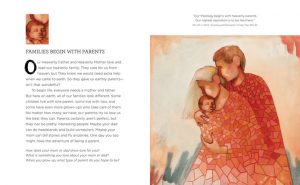 I believe there is an inherent, ongoing tension between a personal, individual connection to God and a more family- and community- oriented relationship to the Divine. The book focuses on sanctification through family life (the cover is a great representation of this uniquely Mormon doctrine), but I also notice that in the written language the book is addressed to “you” and the questions are mostly personal: “What makes you laugh the hardest with your family? How can you help make work fun?” Can you talk more about this tension between individual and community faith? Was it something that shape the book?
I believe there is an inherent, ongoing tension between a personal, individual connection to God and a more family- and community- oriented relationship to the Divine. The book focuses on sanctification through family life (the cover is a great representation of this uniquely Mormon doctrine), but I also notice that in the written language the book is addressed to “you” and the questions are mostly personal: “What makes you laugh the hardest with your family? How can you help make work fun?” Can you talk more about this tension between individual and community faith? Was it something that shape the book?Interesting question. And since Bethany and I never talked about that explicitly I would say the short answer is no, it did not shape the book. However, in thinking more about that, it has to have shaped the book as it is something we both carry around with us.I’ll talk from my personal angle on this— I live in India where there is no word in Hindi (one of the main languages spoken here in a country of billion)— for “privacy.” And if there is no word, I believe there is no concept. India is a completely family/community/communal/public society. However, worship is considered completely individual… people leave their families to to worship or retreat from life or meditate. Worship at a temple may be done in the jostling company of everyone who rode the same bus in, but there is no communal worship.
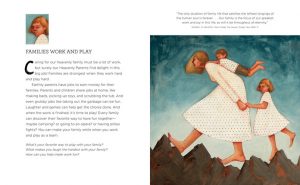 We as Mormons, of course, have those ideas of personal and communal worship completely enmeshed. So while my relationship to my Heavenly Father and Heavenly Mother and Jesus is personal (my growth and weaknesses and progress and failures is between them and me) we all know that coming together— in family or congregation— is a key structure. I would go so far as to say vital.
We as Mormons, of course, have those ideas of personal and communal worship completely enmeshed. So while my relationship to my Heavenly Father and Heavenly Mother and Jesus is personal (my growth and weaknesses and progress and failures is between them and me) we all know that coming together— in family or congregation— is a key structure. I would go so far as to say vital.
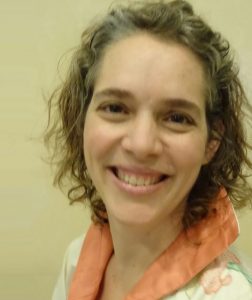 McArthur Krishna comes from a pack of storytellers. With a master’s degree in communications from BYU, she co-owned Free Range, an award-winning marketing business focused on telling social justice stories. After she moved to the Magic Land of India, she got married and started writing books and raising kids.
McArthur Krishna comes from a pack of storytellers. With a master’s degree in communications from BYU, she co-owned Free Range, an award-winning marketing business focused on telling social justice stories. After she moved to the Magic Land of India, she got married and started writing books and raising kids.
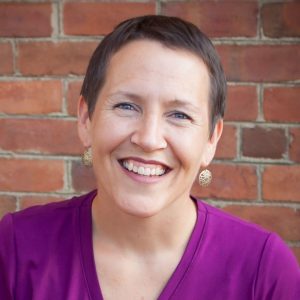 Bethany Brady Spalding likes to stir things up in the kitchen and in the community. She has founded programs to promote health and nutrition in the USA, South Africa, and India. Bethany currently leads a regional coalition in Richmond, Virginia, to create a healthier food environment for at-risk children. She finds joy eating spicy dishes and exploring wild places with her husband, Andy, and their three fiery girls.
Bethany Brady Spalding likes to stir things up in the kitchen and in the community. She has founded programs to promote health and nutrition in the USA, South Africa, and India. Bethany currently leads a regional coalition in Richmond, Virginia, to create a healthier food environment for at-risk children. She finds joy eating spicy dishes and exploring wild places with her husband, Andy, and their three fiery girls.
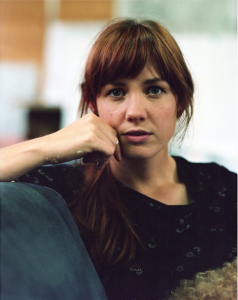 Caitlin Connolly is an artist living in Provo, Utah. Her artwork often explores the female experience as she seeks to understand herself and all women more fully. Her artwork is a part of private and public collections and can be viewed comprehensively at caitlinconnolly.com.
Caitlin Connolly is an artist living in Provo, Utah. Her artwork often explores the female experience as she seeks to understand herself and all women more fully. Her artwork is a part of private and public collections and can be viewed comprehensively at caitlinconnolly.com.
